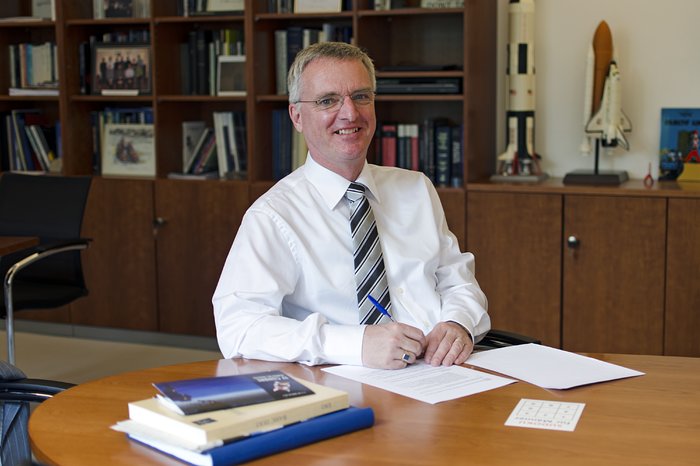Tim de Zeeuw
Tim de Zeeuw, ESO Director General since September 2007, was born in the Netherlands.
He received a degree in mathematics from Leiden University, the Netherlands, in 1976, and one in astronomy in 1977. He graduated with a PhD in astronomy from the same university in 1984.
From 1984, he worked in the USA, first as a long-term Member at the Institute for Advanced Study in Princeton, then, from 1988, as a Senior Research Fellow at the California Institute of Technology.
He came back to the Netherlands in 1990 to become Professor of Theoretical Astronomy at Leiden University. In 1993, he became the founding director of NOVA, the Netherlands Research School for Astronomy, which coordinates the graduate education and astronomical research at the five university astronomy institutes in the Netherlands. NOVA's mission is to train young astronomers at the highest international level and to carry out frontline astronomical research in the Netherlands. In particular, the NOVA programme resulted in Dutch participation in the development of many VLT/VLTI instruments, the Band 9 ALMA receivers, in studies for ELT instruments, and in an instrument for the James Webb Space Telescope (JWST). In 2003, he was appointed Scientific Director of Leiden Observatory, a research institute in the College of Mathematics and Natural Sciences of Leiden University.
Tim de Zeeuw's research concentrates on the formation, structure and dynamics of galaxies, including our own, the Milky Way. In Leiden, he led a group active in the construction of state-of-the-art dynamical models for galaxies, and their comparison to high-quality photometric and spectroscopic observations, with the aim of establishing the properties of dark matter halos around galaxies, probing the supermassive nuclear black holes, measuring the kinematics and dynamics of the different stellar populations, and ultimately understanding the process of galaxy formation. A significant second line of research is the study of the origin, structure, and evolution of young stellar groups in the Solar Neighbourhood.
Trained as a theorist in stellar dynamics, he gradually expanded his research to include the analysis and interpretation of observations, and also became involved in the development of new instrumentation. In 1995, he initiated a project with R. Bacon and R. Davies to build SAURON, a panoramic integral-field spectrograph for the 4.2-m William Herschel Telescope (WHT). The SAURON collaboration led to follow-up projects studying galactic nuclei with the VLT, to the initiative to move the integral field spectrograph OASIS from the Canada France Hawaii Telescope to the WHT and to equip the WHT with a laser guide-star, to participation in studies for possible integral-field units on the Hubble Space Telescope and JWST, and to participation in the development of MUSE for the VLT.
Tim de Zeeuw has (co)-authored 185 refereed papers and many other contributing papers. He has supervised the research projects of 25 master students and has guided the research of 60 graduate students and postdocs, many of whom now hold tenured positions in astronomy. He holds honorary doctorates from the Université Claude Bernard Lyon and the University of Chicago.
Together with W. van Saarloos and L. Peletier, he co-founded the Lorentz Center, the International Center for Astronomy, Mathematics and Physics, in Leiden, and served on its Steering Committee for a decade.
Tim de Zeeuw served on the HST Time Allocation Committee, chaired the Space Telescope Institute Council for four years and also served on the Board of Directors of the US-based Association of Universities for Research in Astronomy. Between 2003 and 2006, he was a member of ESO's governing body, the Council, and chaired the Council Scientific Strategy Working Group. In this capacity he contributed to the development of ESO's strategic goals in 2004 and to changes in the ESO committee structure including the new terms of reference for the STC and OPC. He was the principal author of a report to Council outlining three scenarios for ESO's future role in European astronomy. In 2006/7, he chaired the Science Vision Working Group setup by ASTRONET, an ERA-NET activity funded by the European Commission and set up by funding agencies in Europe. The Science Vision Working Group established a global European Science Vision for Astronomy for the next 20 years.
He is married to astronomer Ewine van Dishoeck.
Credit:ESO
About the Image
| Id: | dg-7k1161 |
| Type: | Photographic |
| Release date: | 18 April 2013, 11:48 |
| Size: | 4656 x 3101 px |
About the Object
| Name: | European Southern Observatory |
| Type: | Unspecified : People |
| Category: | People and Events |
